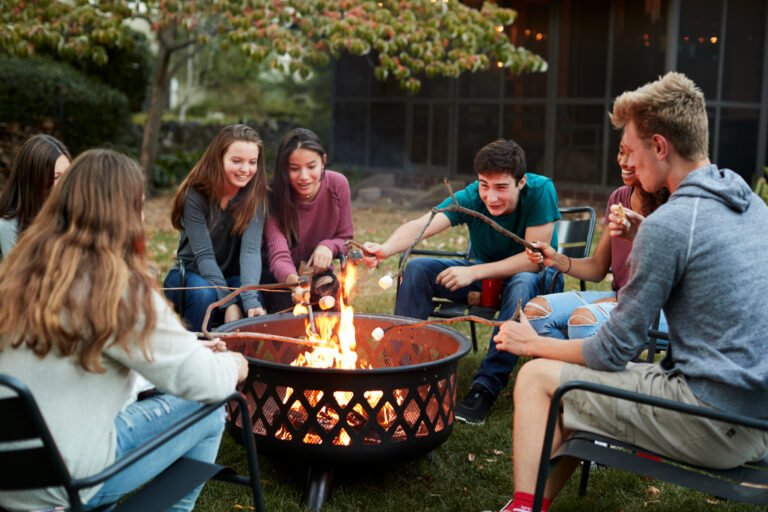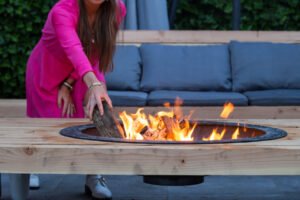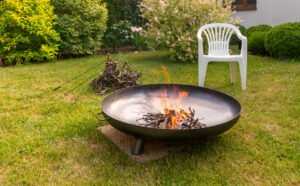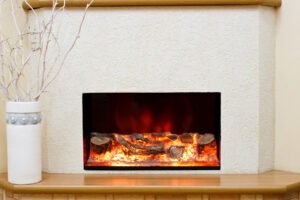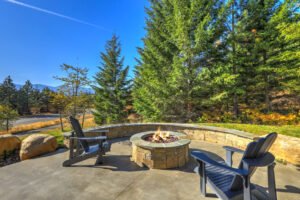An outdoor fireplace in your backyard is on everyone’s bucket list. The idea of getting a fire pit for your home is excellent; however, installing and using it can be difficult. So, it is good to be aware of fire pits do’s and don’ts to avoid making mistakes.
That is why we are going to provide you with answers to the questions related to general mistakes you might make while using an outdoor fire pit. The guide below will help you use your fire pit to the fullest without the fire hazard. Let’s get started!
Can You Use Stone for a Fire Pit?
One of the major mistakes you can make is choosing the wrong type of stone to build your fire pit. As the fire pit holds fire and burns continuously, it inevitably produces a lot of heat and embers.
So you should always be wise and choose a suitable stone that is heat resistant, or the risk of stone cracking and breaking under extreme heat increases. Some of the best stones for fire pits are listed below:
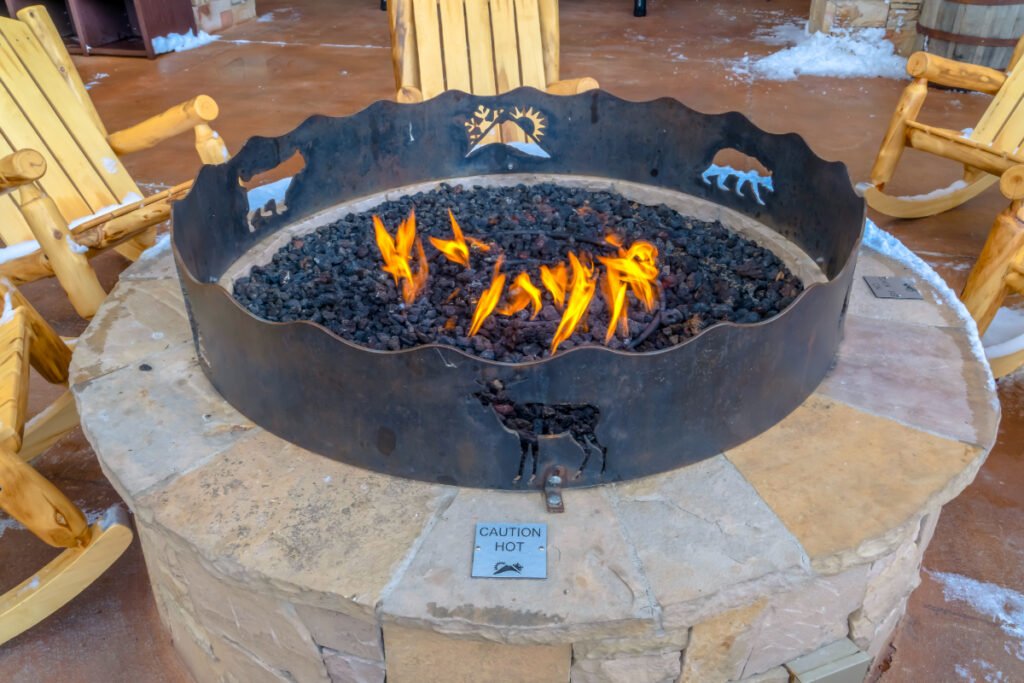
- Granite: Granite is the popular choice as it is durable and visually appealing, and it will not quickly explode and stay cool to the touch. Also, you will find different types, sizes, colors, patterns, and shapes that will make your fire pit look unique.
- Limestone: The limestone’s fine-grain surface gives the fire pit a rich and silky texture and appearance. It won’t get too hot but maintains a moderate temperature. You can also get it in various sizes and colors.
- Sandstone: Sandstone is similar to limestone but with larger grains that provide a rich texture and a variety of patterns. Also, it absorbs heat from the fire pit but does not overheat, making it a safer option if you have kids around.
If you need more information on what to put around a fire pit, check here.
Why Do Fire Pits Explode?
Another vital mistake while building and using a fire pit is building it on the wrong material, which can even cause explosions. Some inappropriate materials include concrete blocks, river rocks, pea gravel, etc.
The primary mechanism behind this is the ability of these materials to trap water. For instance, when river rocks trap water inside of them and are simultaneously exposed to extreme heat, this process tends to lead to an explosion.
Hard rocks like granite, marble, sandstone, slate, etc., are perfect materials for building your fire pit. Likewise, the best rocks to put in your fire pit include fire-rate brick, lava rock, lava glass, etc.
Finally, be cautious while lighting rocks after rain, as wet rocks tend to explode compared to dry rocks.
Is It Safe to Use All Kinds of Wood in a Fire Pit?
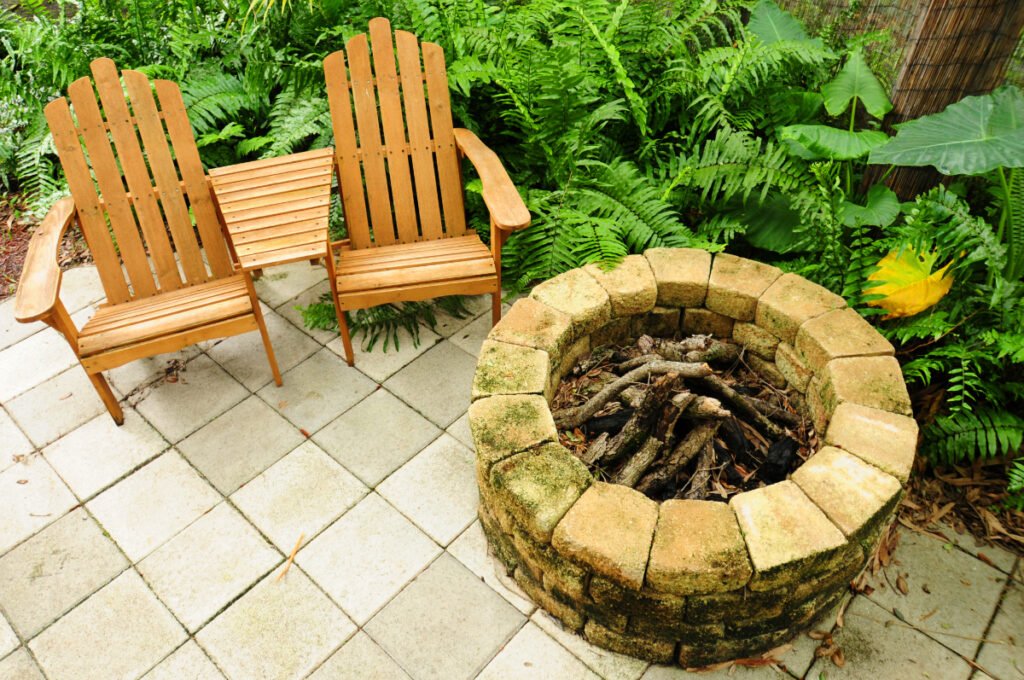
No, it is highly mistaken to think you can put all kinds of wood in a fire pit because not all wood is safe. The best woods to burn in a fire pit are oak, hickory, and birch, known for quick burning.
In addition, you can use olive, Alderwood, and pine for a night-long slow-burning effect. But if you are looking for a smokeless fire pit, maple and poplar wood are your go-to.
Finally, if you want a wood fire with an added advantage, pecan wood is the best choice as it leaves excellent coals that can be used for various purposes. But remember to be cautious as some of these woods give out a lot of embers that can spark a fire.
Woods You Should Never Burn in Your Fire Pit
- Pressure-treated Wood: Pressure-treated woods are woods treated with various chemicals. It is highly advisable not to burn this wood in a fire pit as it can release toxins into the environment.
- Elm Wood: Though elm wood gives out light, burns slowly, and lasts longer, it is incredibly harmful when contacted with metal as its bark contains hydrocyanic acid, which causes suffocation and can lead to death.
- Painted Wood: Painted wood is susceptible to releasing toxic fumes and should be avoided while burning. Some of the woods may even contain lead paint, which is highly harmful.
- Beech Wood: Beechwood produces a pleasant and sweet smell, but the ashes can cause coughing and sneezing.
- Green or Soft Woods: You should not burn green, softwood, or drifted woods, as they are freshly cut and have a lot of moisture, which will make them not burn quickly and give out a lot of smoke.
- Wooden Pallets: Some of the wooden palettes and construction wood are treated with a harmful chemical named methyl Bromide, often labeled as MB, which can be released when burned, harming you and the environment.
Does Your Fire Pit Smoke a Lot?
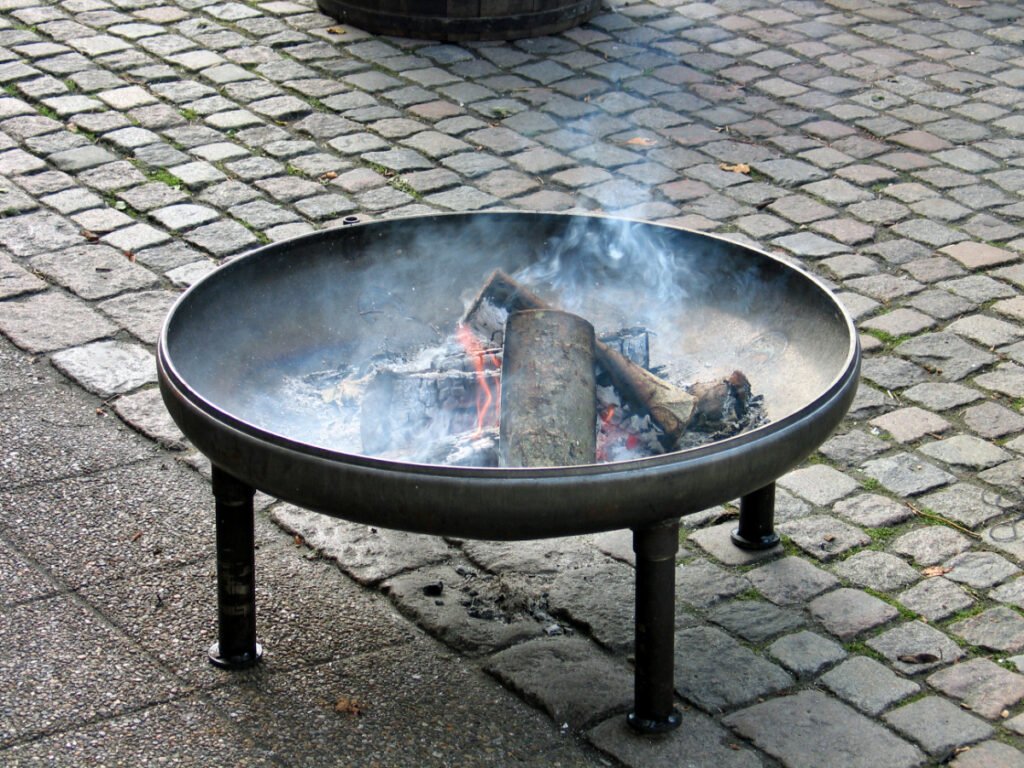
If your fire pit is smoking a lot, you made a crucial mistake of putting greenwoods or softwoods in it. These woods have moisture content and are wet, which leads to incomplete burning that further produces smoke.
Another reason is that some woods contain naturally occurring substances such as sap or pitch, which can produce a lot of smoke. Additionally, the ash and debris in your fire pit can also slow the ignition and produce smoke.
You can create a smokeless fire pit by avoiding green wood and softwoods; instead, use hardwoods, older woods, and kiln-dried woods. You can also check the moisture content of your wood using a moisture meter and ensure the level is less than 30%.
Can You Burn Anything in a Fire Pit?
One of the biggest mistakes is thinking that you can burn all flammable or nonflammable materials in your fire pit. However, that is not correct; there are certain materials that you should avoid at all costs.
You should never burn magazines, cardboard, wrapping paper, junk mail, and other paper materials with ink on them in a fire pit in your backyard, as they can release toxic gases. Likewise, plastics contain harmful chemicals like dioxins and should always be avoided.
Surprisingly, natural plants like sumac can also release poisonous fumes, which can cause severe health issues. Lastly, remember not to make the major mistake of putting fuel in your fire pit, as it can rage a massive fire.
And if you want to know more about what to burn in your fire pit, let me guide you through it!
Is Your Fire Pit the Right Size and Weight?
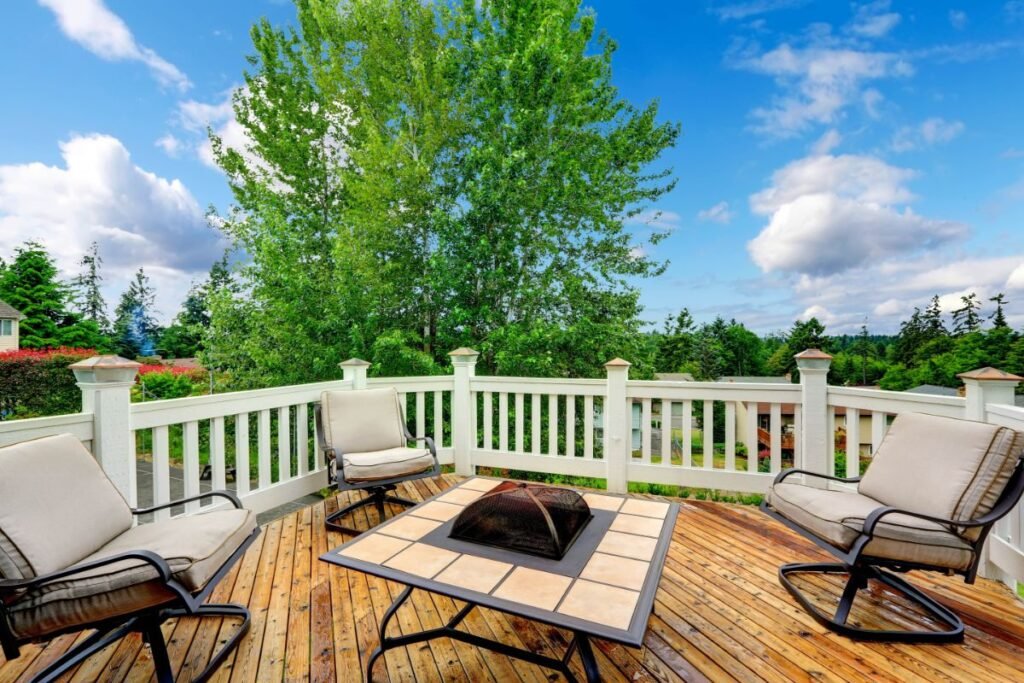
The fire pit’s size is a concern, as it can be challenging to decide on the right size for your area. Most people tend to make this mistake.
Small fire pits can be too tiny for your yard, and a huge fire pit can be too big. So you should know the ideal width of a small fire pit is around 3 feet wide, and the larger fire pit should be about 6 feet wide.
Preferably, the height should be 12-14 inches tall and extend up to 18-20 inches for comfortable seating. You can also use a fire pit table for more convenience and safety in your outdoor living space.
Moreover, if you’re going to install a fire pit on the deck, you must calculate the average fire pit weight plus the average weight of people and furniture that is going to be on the deck before purchasing a fire pit. The total will indicate whether your yard or deck can hold the weight or not.
Also, if you put the fire pit on the grass, you must ensure that the compression is not too much.
Do’s of Using a Fire Pit
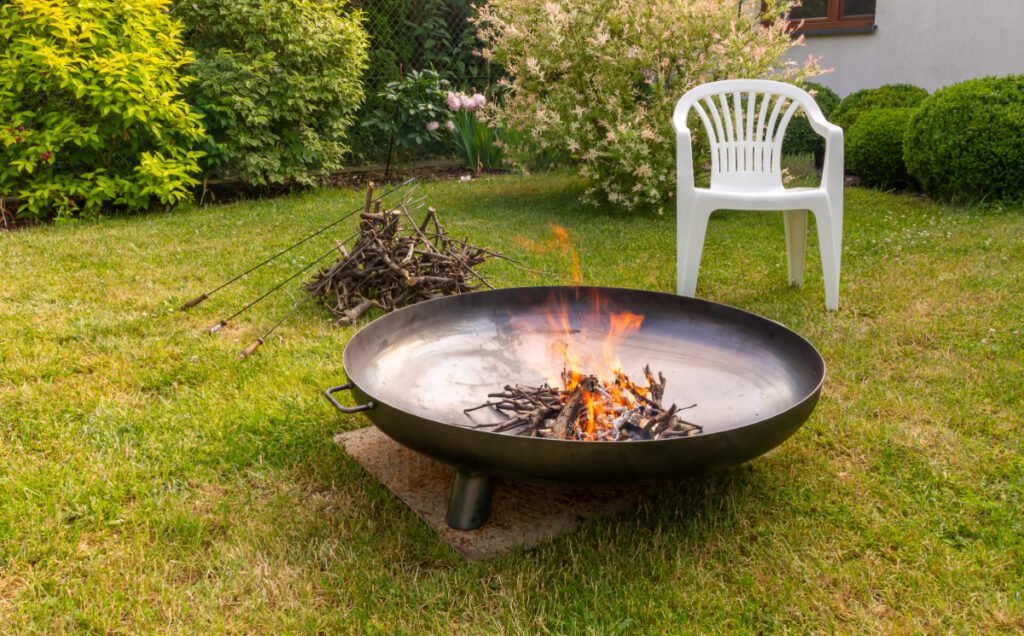
- Check with the fire department or fire marshal to know whether it is legal to place your fire pit on your deck or yard.
- Maintain a safe distance between the fire pits and houses or any nearby flammable structures.
- Always clean the debris left in the fire pit, as burning debris may lead to huge embers that can spark a fire.
- Decide the appropriate and ideal size, height, width, and weight of the fire pit and customize it accordingly.
- Customize your DIY fire pit after thoroughly researching different fire pits, such as a gas fire pit, fire bowl, propane fire pit, portable fire pit, or wood-burning fire pit, and choose the most suitable backyard fire pit design as per your needs.
- Install a steel ring inside the inner wall of your fire pit to prevent the wall from drying out and crumbling, thereby extending its life span.
- Consider the proper fuel or natural gas and the right way to equip it. For example, ethanol might require a tank or tray, while propane gas may require a connection to the liquid propane tank.
- Clear the area around the fire pit of any flammable material, such as dry leaves, withered grass, or plastics.
- Ensure you get a return on investment when weighing building costs and selling your home.
- For additional protection, invest in fire pit accessories such as a spark screen, flame guard, fire table, metal cover, etc.
- Always use a protective surface underneath the fire pit, such as a concrete base, fire pit mat, or fire pad, for the safety of the surface.
- Invest in fire safety gear such as a fire extinguisher or fire blanket and keep a water source like a bucket or a hose in case of accidental fire mishaps.
- Apply a layer of sand or lava rocks under your fire pit for additional heat protection between the surface and the fire pit.
- Always arrange an escape route beforehand in case of fire hazards.
Don’ts of Using a Backyard Fire Pit
- Don’t place a fire pit near combustible materials like wood logs, dry leaves, or flammable structures such as houses, railings, and trees.
- Don’t build a fire pit without the approval of the fire department, housing ordinances, and local authorities.
- Don’t leave a fire pit unattended, as unextinguished fire can pose an accidental fire danger.
- Don’t burn a fire pit in unfavorable weather, such as heavy winds, which can cause embers to fly and spark a fire.
- Don’t forget to clear debris and wood ash left in the fire pit.
- Don’t build a permanent fire pit if you have limited space, but go for a portable one.
- Don’t place a fire pit directly on any surface to restrain heat damage.
- Don’t use fuel accelerants, as they can quickly spark fire, leading to mishaps.
- Don’t use a straight stream of water to extinguish the fire pit, as it can cause embers to fly out when in contact with fire.
Do bricks explode in a fire pit?
Some bricks, such as masonry bricks, can degrade or explode when exposed to extreme fire and heat. However, lining a fire pit with a fire brick can withstand high temperatures.
Why will my gas logs not stay lit?
The main reason is thermopile and thermocouple, which can hamper the ignition of your fire pit. You should also check the gas pressure as incorrect gas pressure can also cause ignition problems in a gas fire pit.
How do you arrange logs in a fire pit?
The best way to arrange logs in a fire pit is to place them parallel and stack them perpendicularly as you move to the top.
If you want to enjoy the weather sitting around a lovely fire pit safely, the above guide will help you understand what you should and shouldn’t do with a fire pit in your outdoor space. This will not only make your job easier, but these safety tips will also help you be extra careful while handling fire.
But if you don’t want to do all this, you can simply replace your traditional firepit with one of the effective fire pit alternatives I’ve listed in my next guide!

